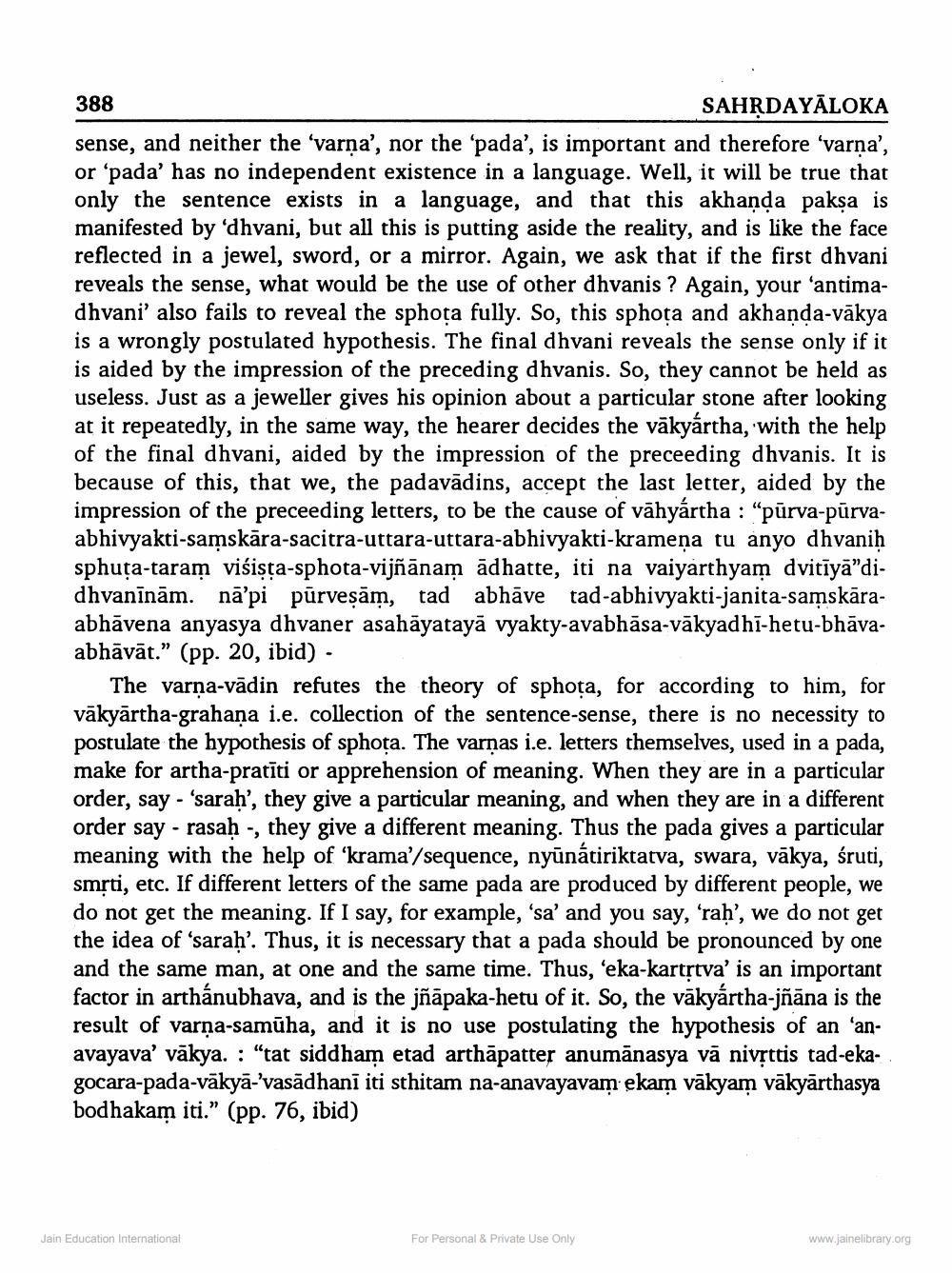________________
388
SAHRDAYĀLOKA sense, and neither the 'varna', nor the 'pada', is important and therefore 'varna', or 'pada' has no independent existence in a language. Well, it will be true that only the sentence exists in a language, and that this akhanda paksa is manifested by 'dhvani, but all this is putting aside the reality, and is like the face reflected in a jewel, sword, or a mirror. Again, we ask that if the first dhvani reveals the sense, what would be the use of other dhvanis ? Again, your 'antimadhvani' also fails to reveal the sphoța fully. So, this sphoța and akhanda-vākya is a wrongly postulated hypothesis. The final dhvani reveals the sense only if it is aided by the impression of the preceding dhvanis. So, they cannot be held as useless. Just as a jeweller gives his opinion about a particular stone after looking at it repeatedly, in the same way, the hearer decides the vākyártha, 'with the help of the final dhvani, aided by the impression of the preceeding dhvanis. It is because of this, that we, the padavādins, accept the last letter, aided by the impression of the preceeding letters, to be the cause of vāhyártha : “pūrva-pūrvaabhivyakti-samskāra-sacitra-uttara-uttara-abhivyakti-kramena tu anyo dhvanih sphusa-taram višişta-sphota-vijñānam ādhatte, iti na vaiyarthyam dvitīyā"didhvanīnām. nā'pi pūrvesām, tad abhāve tad-abhivyakti-janita-samskāraabhāvena anyasya dhvaner asahāyatayā vyakty-avabhāsa-vākyadhi-hetu-bhāva. abhāvāt.” (pp. 20, ibid).
The varna-vādin refutes the theory of sphoța, for according to him, for vākyārtha-grahana i.e. collection of the sentence-sense, there is no necessity to postulate the hypothesis of sphota. The varnas i.e. letters themselves, used in a pada, make for artha-pratīti or apprehension of meaning. When they are in a particular order, say - 'sarah', they give a particular meaning, and when they are in a different order say - rasah , they give a different meaning. Thus the pada gives a particular meaning with the help of 'krama/sequence, nyūnátiriktatva, swara, vākya, śruti, smrti, etc. If different letters of the same pada are produced by different people, we do not get the meaning. If I say, for example, 'sa' and you say, 'rah', we do not get the idea of 'sarah'. Thus, it is necessary that a pada should be pronounced by one and the same man, at one and the same time. Thus, 'eka-kartstva' is an important factor in arthánubhava, and is the jñāpaka-hetu of it. So, the vākyártha-jñāna is the result of varņa-samūha, and it is no use postulating the hypothesis of an 'anavayava' vākya. : "tat siddham etad arthāpatter anumānasya vā nivsttis tad-ekagocara-pada-vākyā-'vasādhani iti sthitam na-anavayavam ekam vākyam vākyārthasya bodhakam iti.” (pp. 76, ibid)
Jain Education International
For Personal & Private Use Only
www.jainelibrary.org




